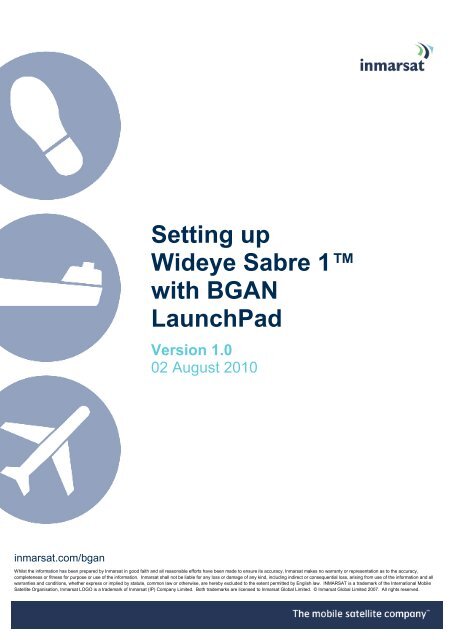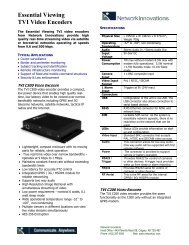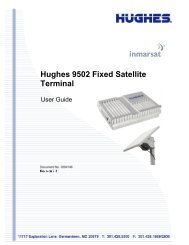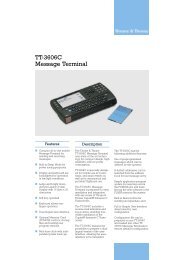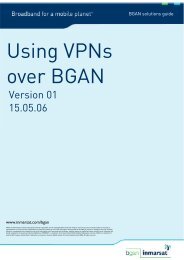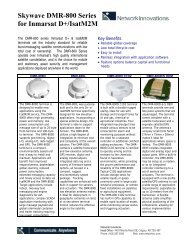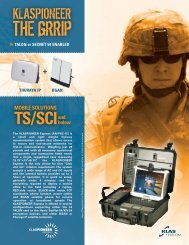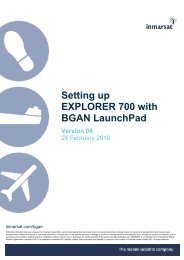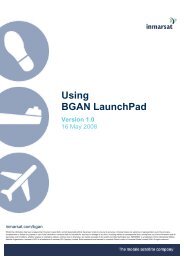Setting up Wideye Sabre 1™ with BGAN LaunchPad - Inmarsat
Setting up Wideye Sabre 1™ with BGAN LaunchPad - Inmarsat
Setting up Wideye Sabre 1™ with BGAN LaunchPad - Inmarsat
You also want an ePaper? Increase the reach of your titles
YUMPU automatically turns print PDFs into web optimized ePapers that Google loves.
<strong>Setting</strong> <strong>up</strong><strong>Wideye</strong> <strong>Sabre</strong> 1<strong>with</strong> <strong>BGAN</strong><strong>LaunchPad</strong>Version 1.002 August 2010inmarsat.com/bganWhilst the information has been prepared by <strong>Inmarsat</strong> in good faith and all reasonable efforts have been made to ensure its accuracy, <strong>Inmarsat</strong> makes no warranty or representation as to the accuracy,completeness or fitness for purpose or use of the information. <strong>Inmarsat</strong> shall not be liable for any loss or damage of any kind, including indirect or consequential loss, arising from use of the information and allwarranties and conditions, whether express or implied by statute, common law or otherwise, are hereby excluded to the extent permitted by English law. INMARSAT is a trademark of the International MobileSatellite Organisation, <strong>Inmarsat</strong> LOGO is a trademark of <strong>Inmarsat</strong> (IP) Company Limited. Both trademarks are licensed to <strong>Inmarsat</strong> Global Limited. © <strong>Inmarsat</strong> Global Limited 2007. All rights reserved.
ContentsIntroduction 11 Introduction 11.1 About this guide 11.2 Other sources of information 11.3 Upgrading software 1Getting Started 22 Introducing the terminal 22.1 Physical characteristics 22.2 Interfaces 22.3 Services 23 <strong>Setting</strong> <strong>up</strong> the terminal 33.1 Installing the SIM card and battery 43.2 Powering on and charging the battery 53.3 Obtaining a GPS fix 63.4 Connecting the terminal to your computer 83.5 Installing <strong>BGAN</strong> <strong>LaunchPad</strong> 93.6 Registering <strong>with</strong> the network 9Voice and Data Connections 124 Making voice, data and text connections 124.1 Making a voice connection 124.2 Making an IP Data Connection 124.3 Sending or receiving a text message 18Configuring Terminal Interfaces 195 Bluetooth 195.1 Introduction 196 Ethernet 20
Introduction1 Introduction1.1 About this guideThis document introduces the <strong>Wideye</strong> <strong>Sabre</strong> 1 terminal and explains how to set <strong>up</strong> the terminalfor use on the <strong>BGAN</strong> network, register <strong>with</strong> the network and set <strong>up</strong> data, voice and textconnections.It is intended for first time end-users, Distribution Partners, Service Providers and anyone whowants to use a <strong>BGAN</strong> terminal to connect to the <strong>BGAN</strong> network and use network services. Aprevious knowledge of satellite communications is useful, but not essential.The sections include:• Introducing the terminal – a brief overview of the physical features and interfaces of the terminaland the available services.• <strong>Setting</strong> <strong>up</strong> the terminal – includes installing the battery and SIM card, connecting to a computerand registering <strong>with</strong> the network• Making data, voice and text connections – an explanation of how to make a voice call, how tomake IP data connections and how to send and receive a text message.• Managing the terminal and telephony settings.1.2 Other sources of informationRefer to the following documentation for further details:• This is one of a series of PDF documents in <strong>BGAN</strong> Product s<strong>up</strong>port. Product s<strong>up</strong>port isdesigned to help you make the most of your <strong>BGAN</strong> terminal. Other documents in the series areavailable for download from www.inmarsat.com/s<strong>up</strong>port. Click on <strong>BGAN</strong>, then click on Userguides.This Web site also gives further information on the <strong>BGAN</strong> service, including Industry solutions.• For help in using <strong>BGAN</strong> <strong>LaunchPad</strong>, refer to “<strong>BGAN</strong> <strong>LaunchPad</strong> User Guide”, available fordownload from www.inmarsat.com/s<strong>up</strong>port, click on <strong>BGAN</strong>, then click on <strong>LaunchPad</strong>guides.• For further information on the <strong>Sabre</strong> terminal, refer to the “<strong>Sabre</strong> 1 V1 User Guide”, available fordownload from www.wideye.com.sg.1.3 Upgrading software• To download the latest USB drivers and <strong>BGAN</strong> <strong>LaunchPad</strong> software, go towww.inmarsat.com/s<strong>up</strong>port, click on <strong>BGAN</strong>, then select from the options listed underProduct Updates.• To download the latest terminal firmware, select Update > Versions and Availability from<strong>BGAN</strong> <strong>LaunchPad</strong>.<strong>Setting</strong> <strong>up</strong> <strong>Wideye</strong> <strong>Sabre</strong> 1 <strong>with</strong> <strong>BGAN</strong> <strong>LaunchPad</strong> Page 1
Getting Started2 Introducing the terminalThis section introduces the physical characteristics, interfaces and services available on the<strong>Wideye</strong> <strong>Sabre</strong> 1 (also referred to as the “terminal” throughout this document).2.1 Physical characteristicsItemManufacturerPhysical dimensionsWeight (including battery)External powerBattery lifeSpecificationAdd Value295mm x 195mm (11.6in x 7.7in.)1.65kg (3.63lbs)15 Volts DCTransmit: 1 hour continuous at
3 <strong>Setting</strong> <strong>up</strong> the terminalThis section explains how to set <strong>up</strong> the <strong>Wideye</strong> <strong>Sabre</strong> 1 terminal and connect to the <strong>BGAN</strong> network.The steps described are:a. Installing the SIM card and battery.b. Powering on and charging the battery.c. Installing <strong>BGAN</strong> <strong>LaunchPad</strong> on your computer.d. Obtaining a GPS fix.e. Connecting the terminal to your computer using the Ethernet interface.f. Defining DNS <strong>Setting</strong>s.g. Pointing the terminal and registering <strong>with</strong> the <strong>BGAN</strong> network.Pre-requisitesBefore you start, make sure that you have:• The <strong>BGAN</strong> terminal.• The AC mains power adapter, s<strong>up</strong>plied <strong>with</strong> the terminal.• The rechargeable battery, s<strong>up</strong>plied <strong>with</strong> the terminal.• A USIM card, s<strong>up</strong>plied by your Service Provider.• The Ethernet cable s<strong>up</strong>plied <strong>with</strong> the terminal.• The <strong>BGAN</strong> <strong>LaunchPad</strong> installation CD, s<strong>up</strong>plied <strong>with</strong> the terminal. Make sure that your PC orMac has the minimum system requirements for <strong>BGAN</strong> <strong>LaunchPad</strong> (refer to page 4 for details).<strong>Setting</strong> <strong>up</strong> <strong>Wideye</strong> <strong>Sabre</strong> 1 <strong>with</strong> <strong>BGAN</strong> <strong>LaunchPad</strong> Page 3
Minimum system requirements for <strong>BGAN</strong> <strong>LaunchPad</strong>The following are the minimum hardware and software requirements for using <strong>BGAN</strong><strong>LaunchPad</strong> to manage the <strong>Wideye</strong> <strong>Sabre</strong> 1 on your computer.Hardware requirementsYou must have the following on your computer:• S<strong>up</strong>port for Ethernet.• Intel Pentium III CPU, or equivalent.• 100Mb of free hard disk space.• 128Mb of RAM.• CD-ROM drive.• Operating systems: You must have one of the following operating systems on yourcomputer:• Microsoft Windows Vista.• Microsoft Windows XP <strong>with</strong> SP2.• Microsoft Windows 7.• Mac 10.x. or Mac 9.2.3.1 Installing the SIM card and batteryTo prepare the terminal for connection:a. Remove the battery door by placing your thumbs on the battery door and pushing outwards inthe direction shown.b. To insert the battery door, align the guiding rail was shown below. Make a slight twist to thebattery door <strong>with</strong> your thumb to allow the rib (part A) to slide along the guiding rail while pushingit inwards.<strong>Setting</strong> <strong>up</strong> <strong>Wideye</strong> <strong>Sabre</strong> 1 <strong>with</strong> <strong>BGAN</strong> <strong>LaunchPad</strong> Page 4
c. Insert the SIM card, <strong>with</strong> the gold contacts facing left as shown, into the SIM slot. The SIMcard can be removed by pressing on the card and removing it from the slot.d. Installing the battery:e. To charge the battery, insert the Power Adapter connector fully into the Power socket. Do notremove the battery from the <strong>Sabre</strong> whilst it is charging.3.2 Powering on and charging the batteryTo power the terminal using the power adapter:a. Insert the power adapter output connector into the DC Power Socket on the right hand side ofthe terminal.<strong>Setting</strong> <strong>up</strong> <strong>Wideye</strong> <strong>Sabre</strong> 1 <strong>with</strong> <strong>BGAN</strong> <strong>LaunchPad</strong> Page 5
. Insert the plug end into any AC outlet between 100 and 240 VAC.c. Press and hold the On/Off Switch for 3 seconds.d. The wideye logo is displayed on the LCD:NoteThe battery charges automatically whenever the terminal is connected to a power source.3.3 Obtaining a GPS fixThe <strong>BGAN</strong> network requires a valid GPS fix to successfully register your <strong>BGAN</strong> terminal.To obtain a GPS fix:a. Take the <strong>Wideye</strong> <strong>Sabre</strong> 1 outside and place the terminal on a flat surface, facing <strong>up</strong>wards and<strong>with</strong> an unobstructed view of the sky. Ensure that the GPS antenna in the terminal is pointingin the direction of the satellite.b. Press the On/Off Switch for 3 seconds. The terminal performs GPS acquisition automatically.c. Leave the terminal to acquire a GPS fix. This may take a few minutes. Once the GPS fix hasbeen acquired the LCD displays New GPS for 2 seconds.d. The LCD displays the new estimated direction and elevation angle to which the antenna shouldpoint. In addition a GPS indicator is displayed to right of the LCD display to indicate that newGPS coordinates are being used.<strong>Setting</strong> <strong>up</strong> <strong>Wideye</strong> <strong>Sabre</strong> 1 <strong>with</strong> <strong>BGAN</strong> <strong>LaunchPad</strong> Page 6
e. For subsequent use, the terminal will not acquire a new GPS, but will prompt the user ifpreviously stored GPS coordinates should be used.f. Use the Up and Down Buttons to select Yes and then press Enter if stored coordinatesshould be used, or select No and press Enter if a new GPS location is required, then repeatsteps a. through d.About GPSThe Global Positioning System (GPS) uses 24 orbital satellites to fix the position of theterminal anywhere on the globe.• In normal operation, a GPS receiver, such as that built in to the Terminal, needs tobe able to receive signals from at least three satellites so that it can then calculatelatitude, a longitude and an altitude – this position fix is referred to as a 3-dimensional or 3-D fix. If only two GPS satellites can be seen by the GPS receiver,then the last available altitude measurement is assumed and the GPS receivercalculates a position fix based on latitude and longitude only. This simpler positionfix is referred to as a 2-dimensional or 2-D fix and is quicker and easier to obtainthan a 3-D fix, but may be less accurate.Note: You can register <strong>with</strong> the <strong>BGAN</strong> network <strong>with</strong> a 2-D or a 3-D fix.• The GPS receiver may take between a few seconds and 20 minutes to obtain a GPSfix, depending on how frequently the GPS receiver is being used. The frequency ofuse determines the how quickly the GPS Terminal is able to start.• Hot start - if the GPS receiver is being used frequently, (that is, at least every twoto six hours), it is regularly <strong>up</strong>dated <strong>with</strong> data from the GPS satellites and so onlytakes a short time to obtain a GPS fix after being switched on.• Warm start - if a GPS receiver has not been used for more than six hours, then itwill take longer to obtain a GPS fix, perhaps <strong>up</strong> to 45 seconds.• Cold start - if the GPS receiver has not been used for some time or is 300 km ormore from where it was last used, it can take between 10 and 20 minutes toobtain a valid position fix.• Following successful registration and providing the Terminal is left switched on andremains stationary, the GPS is no longer needed. Periodically, the <strong>BGAN</strong> terminalcontacts the <strong>BGAN</strong> network to inform the network that it is still switched on. Inaddition, the <strong>BGAN</strong> network periodically checks each terminal for activity and ifthere has been no traffic through the terminal and the terminal has not automaticallycontacted the <strong>BGAN</strong> network as described above, then the terminal will be deregisteredfrom the network.<strong>Setting</strong> <strong>up</strong> <strong>Wideye</strong> <strong>Sabre</strong> 1 <strong>with</strong> <strong>BGAN</strong> <strong>LaunchPad</strong> Page 7
3.4 Connecting the terminal to your computerConnecting over EthernetNoteFor the Ethernet interface to work <strong>with</strong>out any further set<strong>up</strong>, your computer must beconfigured to obtain an IP address and a DNS server address automatically. To check thatthese settings are configured on your computer, refer to the documentation for youroperating system.NoteFor details on how to configure DNS Server addresses for the terminal, refer to Ethernet onpage 20.To connect the <strong>BGAN</strong> terminal to your computer using Ethernet:a. Insert one connector on the s<strong>up</strong>plied Ethernet cable into the terminal’s Ethernet port.b. Insert the other connector into your computer’s Ethernet port. A message confirmingconnection is displayed on your computer.TipSome corporate computers are configured <strong>with</strong> a static IP address. If your computer has astatic IP address, you must go into your operating system’s IP Properties option andchange your computers settings to obtain an IP address automatically before your computercan communicate <strong>with</strong> the terminal.IP addressing on the <strong>Wideye</strong> <strong>Sabre</strong> 1• In normal operation, the terminal uses its built-in DHCP server to allocate IPaddresses automatically. If you want to manually set <strong>up</strong> IP addressing, you canuse the terminal’s default range of IP addresses, as shown below:Terminal IP address 192.168.1.35Default range of IP addresses 192.168.1.10 to 192.168.1.50Subnet mask 255.255.255.0DNSIf you use <strong>BGAN</strong>.INMARSAT.COM as yourAPN, the default DNS addresses are172.30.66.7 and 172.30.34.7If you use another APN, your DistributionPartner s<strong>up</strong>plies you <strong>with</strong> a DNS addressfor your APN.Refer to the Solutions Guide document “<strong>BGAN</strong> and IP data connections” for furtherdetails.<strong>Setting</strong> <strong>up</strong> <strong>Wideye</strong> <strong>Sabre</strong> 1 <strong>with</strong> <strong>BGAN</strong> <strong>LaunchPad</strong> Page 8
3.5 Installing <strong>BGAN</strong> <strong>LaunchPad</strong>To install <strong>BGAN</strong> <strong>LaunchPad</strong> on your computer:a. Insert the <strong>BGAN</strong> <strong>LaunchPad</strong> Installation CD into your computer's CD-ROM drive.b. Follow the on-screen instructions.Interfacing <strong>with</strong> the <strong>BGAN</strong> terminal<strong>BGAN</strong> <strong>LaunchPad</strong> is <strong>Inmarsat</strong>’s easy-to-use software interface, that provides step-bystepinstructions on connecting to the <strong>BGAN</strong> network and setting <strong>up</strong> satelliteconnections. You can use <strong>BGAN</strong> <strong>LaunchPad</strong> to manage data connections, send andreceive text messages, monitor telephone usage and <strong>up</strong>grade software. The interfacecan be installed on any computer connected to the terminal and accessed by doubleclickingon a desktop icon. With <strong>BGAN</strong> <strong>LaunchPad</strong>, you have access to all the latestcustomisation options and features of the <strong>BGAN</strong> service. You can also <strong>up</strong>datefirmware automatically using <strong>BGAN</strong> <strong>LaunchPad</strong>.3.6 Registering <strong>with</strong> the networkEstablishing a connection and registering successfully <strong>with</strong> the network requires careful orientationof the terminal towards the satellite, a process called pointing. Accurate and precise pointing isimportant, because a badly-pointed antenna can reduce the data rate achievable over the network,or even restrict access to services. When pointing is complete, you can register the terminal <strong>with</strong>the <strong>BGAN</strong> network.Use <strong>BGAN</strong> <strong>LaunchPad</strong> to step through the process of pointing the terminal and registering <strong>with</strong> thenetwork. In addition, you can use the terminal’s signal strength indicator lights and, optionally, theterminal’s audio buzzer to point the terminal. To do this:a. Open <strong>BGAN</strong> <strong>LaunchPad</strong> by clicking on the <strong>BGAN</strong> <strong>LaunchPad</strong> icon on your desktop.The following screen is displayed:The status bar displays the message In Pointing Mode.NoteThe coverage map and “Welcome to <strong>BGAN</strong>” area are provided to assist you in pointing,but the location shown may not correspond to your GPS fix. This does not affectnetwork registration.<strong>Setting</strong> <strong>up</strong> <strong>Wideye</strong> <strong>Sabre</strong> 1 <strong>with</strong> <strong>BGAN</strong> <strong>LaunchPad</strong> Page 9
. <strong>BGAN</strong> <strong>LaunchPad</strong> suggests the recommended pointing angle and direction to correctlyposition the terminal.• Using the terminal’s built-in compass, rotate the terminal left or right until it points in thecorrect horizontal direction, known as the azimuth. Make sure the compass is horizontal toget an accurate reading.• Tilt the terminal slowly <strong>up</strong> or down until it points in the correct vertical direction, known as theelevation.c. Monitor the signal strength on the status bar:Use this information to further adjust the antenna position to obtain optimal signal strength.NoteNoteIf the signal strength is not sufficient, registration may not be possible and theterminal may not be able to open a data connection.<strong>Wideye</strong> <strong>Sabre</strong> 1 has a built-in audio buzzer that can be used to assist <strong>with</strong> antennapointingd. When you have positioned the terminal to obtain the optimal signal strength, you are ready toregister <strong>with</strong> the network. Click on Register <strong>with</strong> Network now.By default, <strong>BGAN</strong> <strong>LaunchPad</strong> opens a standard IP data connection after successfulregistration. The status zone reads Standard Data Connection Open. Ready for Phone,Text and Data.Using <strong>BGAN</strong> <strong>LaunchPad</strong> during pointing and registrationNote the following about <strong>BGAN</strong> <strong>LaunchPad</strong> during pointing and registration:• During pointing, the location shown on the coverage map is based on your previouslocation. The coverage map displays your current position only after you exit pointingand register <strong>with</strong> the network.• During pointing, signal strength information is provided by the satellite’s global beam.Once you have registered, the signal strength is provided by the satellite’s regionalbeam. Therefore the signal strength bar shown in <strong>BGAN</strong> <strong>LaunchPad</strong> may change afterregistration. Once you have opened a data connection, signal strength is provided bythe spot beam.• To check the actual signal strength, select Help > Diagnostic Report in <strong>BGAN</strong><strong>LaunchPad</strong>. The actual signal strength is given in the dialog box that is displayed.<strong>Setting</strong> <strong>up</strong> <strong>Wideye</strong> <strong>Sabre</strong> 1 <strong>with</strong> <strong>BGAN</strong> <strong>LaunchPad</strong> Page 10
TipYou can make or receive phone calls and send and receive a text message even if you donot have an IP data connection.Automatic modeTerminal automatic data connection – By default, the terminal automatically opens a dataconnection after you register <strong>with</strong> the network. However, there is a minimum charge foropening an IP data connection (unless you are on a lease package) and data may betransferred across the connection even if you are not actively using an application (forexample, your computer may be receiving automatic <strong>up</strong>dates).If you do not want to incur these charges, you can switch off the automatic connectionfeature using <strong>BGAN</strong> <strong>LaunchPad</strong>. Refer to “<strong>BGAN</strong> <strong>LaunchPad</strong> User Guide” for details.<strong>Setting</strong> <strong>up</strong> <strong>Wideye</strong> <strong>Sabre</strong> 1 <strong>with</strong> <strong>BGAN</strong> <strong>LaunchPad</strong> Page 11
Voice and Data Connections4 Making voice, data and text connections4.1 Making a voice connectionYou can use any of the following interfaces to make and receive voice calls:• <strong>Wideye</strong> <strong>Sabre</strong> 1 corded analog handset (RJ11 phone).• Bluetooth handset s<strong>up</strong>porting cordless telephone profile (CTP).• Bluetooth headset4.2 Making an IP Data ConnectionPre-requisitesBefore you can open an IP data connection, ensure that you have done the following:• Installed a provisioned SIM card, s<strong>up</strong>plied by your Service Provider. The SIM card containsAccess Point Name (APN) information, therefore <strong>Inmarsat</strong> recommends that you do not changethe APN after installing the SIM card.• Connected your computer to the <strong>BGAN</strong> terminal using the Ethernet interface.• Pointed the terminal to obtain the maximum possible signal strength.• Registered <strong>with</strong> the <strong>BGAN</strong> network.NoteIf the terminal is in automatic connection mode, the first user to connect is automaticallyassigned a data connection. All other users must use <strong>BGAN</strong> <strong>LaunchPad</strong> to open their owndata connection.<strong>Setting</strong> <strong>up</strong> <strong>Wideye</strong> <strong>Sabre</strong> 1 <strong>with</strong> <strong>BGAN</strong> <strong>LaunchPad</strong> Page 12
Opening a standard data connectionBy default, when you first register <strong>with</strong> the <strong>BGAN</strong> network, the terminal opens a standard IP dataconnection. The standard connection is an always-on, best effort connection and is suitable formost basic data applications. It is charged by the amount of data sent and received.To check that the standard connection is open, select the Data tab in <strong>BGAN</strong> <strong>LaunchPad</strong>.The following screen is displayed:If the standard connection is open, the words Disconnect Standard are displayed below theconnection icon.NoteIf the standard connection is closed, the words Connect Standard display below theconnection icon. Click on the icon to open the standard connection.You can now browse the Internet, send and receive email and use other IP applications. All trafficis transferred across the standard connection.NoteIf more than one user wants to open a data connection, each user must open a separatesession of <strong>BGAN</strong> <strong>LaunchPad</strong>. Refer to “<strong>BGAN</strong> and IP data connections” for details.Opening a streaming data connectionIf you require a guaranteed data rate for your connection (if, for example, the application is timecritical), you can connect using one of the dedicated streaming connections at the following datarates:• 32kbps streaming• 64kbps streaming<strong>Setting</strong> <strong>up</strong> <strong>Wideye</strong> <strong>Sabre</strong> 1 <strong>with</strong> <strong>BGAN</strong> <strong>LaunchPad</strong> Page 13
Each streaming class connection is charged by the length of time that the connection is live. Whenyou open a streaming connection, the standard connection is closed.TipBy default, error correction (also called network packet retransmission) is switched off.<strong>Inmarsat</strong> recommends that you turn error correction off for UDP/IP connections, as thisfeature is not required for this connection type. Refer to “<strong>BGAN</strong> and IP data connections”for details.To open a streaming connection:a. Select the Data tab in <strong>BGAN</strong> <strong>LaunchPad</strong>:The following screen is displayed:b. Select the required streaming connection, for example 64 Streaming. You will be prompted toconfirm that you want to close your current connection and open a new connection, charged bytime:c. Click on OK. The new data connection opens and the following screen is displayed:The Standard connection is closed and the 64 Streaming connection is open. All traffic istransferred across the selected streaming connection.NoteNoteIf you subsequently want to close the streaming connection and open another streamingconnection, or reopen the standard connection, repeat steps 1 to 3.If you want to close the currently open connection, click on the icon.<strong>Setting</strong> <strong>up</strong> <strong>Wideye</strong> <strong>Sabre</strong> 1 <strong>with</strong> <strong>BGAN</strong> <strong>LaunchPad</strong> Page 14
Configuring a dedicated streaming connectionIn addition to the default connections, <strong>BGAN</strong> <strong>LaunchPad</strong> enables you to configure and open one ormore dedicated streaming connections (you can associate one of the icons shown above <strong>with</strong> adedicated streaming connection). These are assigned to specific applications, for example WinMedia, to ensure that the connection for this application’s data is not shared <strong>with</strong> any otherapplication.You must open a pre-configured standard or streaming connection (called a primary connection)before you can open a dedicated streaming connection (secondary connection). This is becauseeach dedicated streaming connection creates a virtual IP data connection which shares the IPaddress of the pre-configured standard or streaming connection.For details on configuring dedicated streaming connections, using Win Media as the exampleapplication, refer to “<strong>BGAN</strong> <strong>LaunchPad</strong> User Guide”.Traffic Flow TemplatesEach dedicated streaming connection is associated <strong>with</strong> a Traffic Flow Template (TFT). A TFT,also called an Application Template, assigns a priority to a selected type of traffic in order tomaximize performance.<strong>BGAN</strong> <strong>LaunchPad</strong> s<strong>up</strong>ports the following pre-configured TFTs, any one of which can be selectedwhen you configure a dedicated streaming connection to ensure that the defined traffic has its owndedicated connection:• FTP• QuickLink• QuickTime• Real Media• Streambox• WinMediaIf you wish to want to define your own TFT for another application, contact your Service Provider forassistance.To open a dedicated streaming connection:a. Select the Data tab in <strong>BGAN</strong> <strong>LaunchPad</strong>.<strong>Setting</strong> <strong>up</strong> <strong>Wideye</strong> <strong>Sabre</strong> 1 <strong>with</strong> <strong>BGAN</strong> <strong>LaunchPad</strong> Page 15
. In this scenario, you have set <strong>up</strong> a dedicated streaming connection for Win Media. Thestandard connection is currently open. The newly-created dedicated streaming IP dataconnection (Win Media) has been added to the list of available connections.c. Select the required dedicated streaming connection, for example Win Media. The followingmessage is displayed, asking you to confirm that you want to open a dedicated connection inaddition to your current connection:d. Click on OK. The new data connection opens and the following screen is displayed:The Standard and the Win Media connections are both open. All traffic other than Win Mediadata continues to use the standard connection.You can open <strong>up</strong> to 10 dedicated streaming connections in addition to your default connection.If you can’t make a data connection:If you can’t open a data connection, check that the default Access Point Name (APN) is setcorrectly. The APN is stored on your SIM and must be configured as the access point for each ofyour data connections for the data connection to open successfully.TipIf you want to open a dedicated streaming connection, the APN of the dedicated streamingconnection must be the same as that of the existing standard or streaming connection.<strong>Setting</strong> <strong>up</strong> <strong>Wideye</strong> <strong>Sabre</strong> 1 <strong>with</strong> <strong>BGAN</strong> <strong>LaunchPad</strong> Page 16
To check the default APN is set correctly:a. Select <strong>BGAN</strong> Services > <strong>LaunchPad</strong> APN Options. The APN Configuration screen isdisplayed:b. Verify the Current Default APN text box to ensure you are connected to the correct APN. Ifnot, either:• Click on Fetch from SIM, or• Select the required APN from the Select APN drop-down list and click on Make default.To check that the APN for a specific data connection is set to the default:a. In <strong>BGAN</strong> <strong>LaunchPad</strong>, select the Data tab.The following screen is displayed:Right-click on the connection you want to verify and select Edit. The Primary Connectionscreen is displayed:<strong>Setting</strong> <strong>up</strong> <strong>Wideye</strong> <strong>Sabre</strong> 1 <strong>with</strong> <strong>BGAN</strong> <strong>LaunchPad</strong> Page 17
. Verify the displayed APN in the Select APN field. If it is not correct, select the required APNfrom the drop-down list and click on OK.TipSome Distribution Partners assign usernames and passwords to the APN. You may needto enter these when accessing or changing APN details.4.3 Sending or receiving a text messageYou can send text messages from a <strong>BGAN</strong> terminal to another <strong>BGAN</strong> terminal and from a <strong>BGAN</strong>terminal to a mobile phone. You can also sending a text messages from a mobile phone to a<strong>BGAN</strong> terminal, but only on those networks <strong>with</strong> which <strong>Inmarsat</strong> has an agreement.To access text features, select the Text tab in <strong>BGAN</strong> <strong>LaunchPad</strong>:The following screen is displayed:Refer to “<strong>BGAN</strong> <strong>LaunchPad</strong> User Guide” for details on using this screen.Note<strong>LaunchPad</strong> advises you <strong>with</strong> a pop-<strong>up</strong> message when a new text has been received.<strong>Setting</strong> <strong>up</strong> <strong>Wideye</strong> <strong>Sabre</strong> 1 <strong>with</strong> <strong>BGAN</strong> <strong>LaunchPad</strong> Page 18
Configuring Terminal Interfaces5 Bluetooth5.1 IntroductionNote the following about Bluetooth connections on the <strong>Wideye</strong> <strong>Sabre</strong> 1:• You can connect a Bluetooth handset, a Bluetooth headset or a Bluetooth data device to thebuilt-in Bluetooth antenna on the terminal. One device at a time can connect to the Bluetoothinterface.• The terminal s<strong>up</strong>ports various Bluetooth profiles. Remember to activate/install the profile(s) youare going to use on your computer. For a list of s<strong>up</strong>ported profiles, refer to the documentations<strong>up</strong>plied <strong>with</strong> your terminal.• The Product CD s<strong>up</strong>plied <strong>with</strong> the terminal contains a driver for the <strong>Wideye</strong> Bluetooth DataDongle (not s<strong>up</strong>plied). You can use this dongle if you do not already have a Bluetoothapplication installed on your computer. Refer to the SABRE I User Manual for details oninstalling the driver for the Bluetooth data dongle.• The Bluetooth device should be placed <strong>with</strong>in a maximum distance of 100 m from the terminal.NoteThis is the maximum distance in open air; the actual distance may be shorter, dependingon the environment. In an office environment, you should be able to establish aconnection to an adjoining room.Connecting from your Bluetooth device to the terminalTo search for and pair <strong>with</strong> your Bluetooth-enabled device from the terminal using <strong>BGAN</strong><strong>LaunchPad</strong>:a. Select Terminal > Bluetooth Interface <strong>Setting</strong>s. The Configure Bluetooth Interface dialogbox is displayed:b. If Bluetooth Access is not enabled, check Enable. Note the following:• The device name of the terminal is listed in the Device Name text box. The default is Lotus,but you can change this if required.<strong>Setting</strong> <strong>up</strong> <strong>Wideye</strong> <strong>Sabre</strong> 1 <strong>with</strong> <strong>BGAN</strong> <strong>LaunchPad</strong> Page 19
• The current discoverability mode is displayed as either Enable or Disable. You can changethis if required.• The current passkey displays as encrypted text in the Default Passkey text box. The defaultis 0000, but you can change this if required.NoteThe Bluetooth device that you want to pair <strong>with</strong> must also be enabled.c. Click on List Bluetooth Devices to list all Bluetooth devices <strong>with</strong>in range. A screen similar tothe following is displayed, giving the device address and current status, including pairinginformation.If required, either:• Pair a device by right-clicking on an unpaired device and selecting Pair. Enter the passkeywhen prompted, or• Unpair a device by right-clicking on a paired device and selecting Un-pair.d. Click on OK to save the configured settings, or click on Cancel to exit <strong>with</strong>out saving. Whenyou have paired the device and the terminal, the Bluetooth software automatically installs twoBluetooth modems on your computer, one for <strong>BGAN</strong> <strong>LaunchPad</strong> and one for dial-<strong>up</strong>networking.e. <strong>BGAN</strong> <strong>LaunchPad</strong> automatically detects the Bluetooth connection and you can use your deviceto access Bluetooth services.6 EthernetThe <strong>Wideye</strong> <strong>Sabre</strong> 1 Ethernet interface s<strong>up</strong>ports two operating modes:Router Mode. This is the default mode. In this mode the terminal acts as a router. This modeuses standard TCP/IP over Ethernet to connect to the network. If you choose this mode, theterminal initially assigns an IP address to the connected device, then allocates a public IP address.Bridge Mode. In this mode the terminal acts as a modem. This mode requires you to installdevice drivers on your computer to create a serial connection. If you choose this mode, the corenetwork allocates a public IP address directly to your computer (or other connected equipment).Refer to the documentation s<strong>up</strong>plied <strong>with</strong> your terminal for details on installing the device drivers.To activate and configure the Ethernet interface:<strong>Setting</strong> <strong>up</strong> <strong>Wideye</strong> <strong>Sabre</strong> 1 <strong>with</strong> <strong>BGAN</strong> <strong>LaunchPad</strong> Page 20
a. Select Terminal > Configure Ethernet. The following screen is displayed:b. Check either Bridge Mode or Router Mode, or alternatively turn the Ethernet interface Off.c. Click on Advanced to configure DHCP and DNS settings. The DHCP Configuration screenis displayed:d. Turn the DHCP Server On, if required. The screen displays the current DHCP AddressRange, and the IP addresses of the 1st and, if required, 2nd DNS Server.e. If required, edit the DHCP address range by typing in a new start IP address in the Fromfields, and a new end IP address in the To fields.<strong>Setting</strong> <strong>up</strong> <strong>Wideye</strong> <strong>Sabre</strong> 1 <strong>with</strong> <strong>BGAN</strong> <strong>LaunchPad</strong> Page 21
f. If you chose Router Mode, and you are using a DNS Server <strong>with</strong> a static IP address, you canchange the IP address of the DNS Server. Type in the IP address of the 1st, and, if required,the 2nd DNS Server.g. Click on OK to save settings.<strong>Setting</strong> <strong>up</strong> <strong>Wideye</strong> <strong>Sabre</strong> 1 <strong>with</strong> <strong>BGAN</strong> <strong>LaunchPad</strong> Page 22
Managing the terminal7 Enabling or disabling audio screenThe terminal has a built in audio buzzer which you can use to assist you in pointing the terminal.To turn the audio buzzer on or off:a. Select Terminal > Audio Screen. The Audio Screen dialog box is displayed:b. Check either On or Off to switch the audio screen on or off as required.c. Click on OK to save the setting, or on Cancel to exit <strong>with</strong>out saving.8 Restarting the terminalIf required, you can turn the terminal off and back on again from <strong>LaunchPad</strong>.To do this:a. Select Terminal > Restart Terminal. The Restart Terminal dialog box is displayed:b. Click on OK to restart the terminal.<strong>Setting</strong> <strong>up</strong> <strong>Wideye</strong> <strong>Sabre</strong> 1 <strong>with</strong> <strong>BGAN</strong> <strong>LaunchPad</strong> Page 23
Telephony settings9 Viewing telephone numbersYou can display the terminal’s telephone numbers in <strong>LaunchPad</strong> if they have been s<strong>up</strong>plied byyour service provider.To do this:a. Select <strong>BGAN</strong> services > Telephony <strong>Setting</strong>s (or click on Advanced in the Phone window).The Telephony settings window is displayed:b. The telephone numbers available to you are displayed in the Telephone numbers tab.<strong>Setting</strong> <strong>up</strong> <strong>Wideye</strong> <strong>Sabre</strong> 1 <strong>with</strong> <strong>BGAN</strong> <strong>LaunchPad</strong> Page 24
10 <strong>Setting</strong> <strong>up</strong> call forwardingYou can forward incoming calls to another phone using the Call Forwarding options.To select call forwarding options:a. Select <strong>BGAN</strong> services > Telephony <strong>Setting</strong>s: (or click on Advanced in the Phone window).The Telephony <strong>Setting</strong>s window is displayed.b. Select the Call Forwarding tab. The following window is displayed:c. From the drop-down list, select the service on which you want to set <strong>up</strong> call forwarding, eitherVoice or Data.d. Check Enable or Disable for each call forwarding option as required. If you enable a callforwarding option, enter the number of the telephone to which you want to forward the call inthe text box alongside your selection. If you check Divert if not answered, enter the amountof time you want the phone to ring unanswered before the call is diverted, in the Secondsunanswered text box.e. If required, click on Current Values to display the current network settings for this service.f. Click on Apply to save the displayed configuration, and select another Telephony settingstab, click on Save to save the displayed configuration and exit the Telephony settings screen,or click on Cancel to exit <strong>with</strong>out saving.<strong>Setting</strong> <strong>up</strong> <strong>Wideye</strong> <strong>Sabre</strong> 1 <strong>with</strong> <strong>BGAN</strong> <strong>LaunchPad</strong> Page 25
11 <strong>Setting</strong> <strong>up</strong> call barringYou can bar selected types of outgoing or incoming call using the Call Barring options. Beforeyou can do this, you must enter the PIN s<strong>up</strong>plied by your Service Provider.To select call barring options:a. Select <strong>BGAN</strong> services > Telephony <strong>Setting</strong>s: (or click on Advanced in the Phone window).The Telephony <strong>Setting</strong>s window is displayed.b. Select the Call Barring tab. The following window is displayed:c. In the Telephone number drop-down list, select the service on which you want to set <strong>up</strong> callbarring: either Voice or Data.d. In the Barring PIN text box, enter the PIN s<strong>up</strong>plied by your Service Provider. You cannot set<strong>up</strong> call barring options unless you enter the correct PIN.e. Check any box if you want to activate a call barring service. If you choose Cancel all callbarring, no other services are available to you. You must uncheck this box again to haveaccess to the other services.f. If required, click on Current Values to display the current network settings for this service.g. Click on Apply to save the displayed configuration, and select another Telephony settingstab, click on Save to save the displayed configuration and exit the Telephony settings screen,or click on Cancel to exit <strong>with</strong>out saving.<strong>Setting</strong> <strong>up</strong> <strong>Wideye</strong> <strong>Sabre</strong> 1 <strong>with</strong> <strong>BGAN</strong> <strong>LaunchPad</strong> Page 26
12 <strong>Setting</strong> <strong>up</strong> caller IDYou can enable caller ID if you want to see the number of an incoming caller, or allow a caller tosee your number.To set <strong>up</strong> caller ID:a. Select <strong>BGAN</strong> services > Telephony <strong>Setting</strong>s: (or click on Advanced in the Phone window).The Telephony <strong>Setting</strong>s window displays.b. Select the Caller ID tab. The following window is displayed:c. Check Allow Called Party to see your number if you want to allow the caller to see yournumber.d. Check Show alert <strong>with</strong> calling party number for incoming calls if you want to see thenumber of an incoming caller.e. If required, click on Current Values to display the current network settings for this service.Click on Apply to save the displayed configuration, and select another Telephony settingstab, click on Save to save the displayed configuration and exit the Telephony settingsscreen, or click on Cancel to exit <strong>with</strong>out saving.<strong>Setting</strong> <strong>up</strong> <strong>Wideye</strong> <strong>Sabre</strong> 1 <strong>with</strong> <strong>BGAN</strong> <strong>LaunchPad</strong> Page 27
13 <strong>Setting</strong> <strong>up</strong> call waitingYou can enable call waiting if you want to be notified that another caller is waiting which you are ona call.To set <strong>up</strong> call waiting:a. Select <strong>BGAN</strong> services > Telephony <strong>Setting</strong>s: (or click on Advanced in the Phone window).The Telephony <strong>Setting</strong>s window is displayed.b. Select the Call Waiting tab. The following window is displayed:c. Check Enable Call Waiting to activate call waiting, or uncheck to turn call waiting off.d. If required, click on Current Values to display the current network settings for this service.e. Click on Apply to save the displayed configuration, and select another Telephony settingstab, click on Save to save the displayed configuration and exit the Telephony settings screen,or click on Cancel to exit <strong>with</strong>out saving.<strong>Setting</strong> <strong>up</strong> <strong>Wideye</strong> <strong>Sabre</strong> 1 <strong>with</strong> <strong>BGAN</strong> <strong>LaunchPad</strong> Page 28
14 Configuring Interface Statusa. Select <strong>BGAN</strong> services > Telephony <strong>Setting</strong>s: (or click on Advanced in the Phone window).The Telephony <strong>Setting</strong>s window is displayed.b. Select the Interface status tab. The following window is displayed:c. Check US or European Caller Line ID Phone connected or Disable Telephone interface ifno interface is required..d. If required, click on Current Values to display the current network settings for this service.e. Click on Apply to save the displayed configuration, and select another Telephony settingstab, click on Save to save the displayed configuration and exit the Telephony settings screen,or click on Cancel to exit <strong>with</strong>out saving.<strong>Setting</strong> <strong>up</strong> <strong>Wideye</strong> <strong>Sabre</strong> 1 <strong>with</strong> <strong>BGAN</strong> <strong>LaunchPad</strong> Page 29


